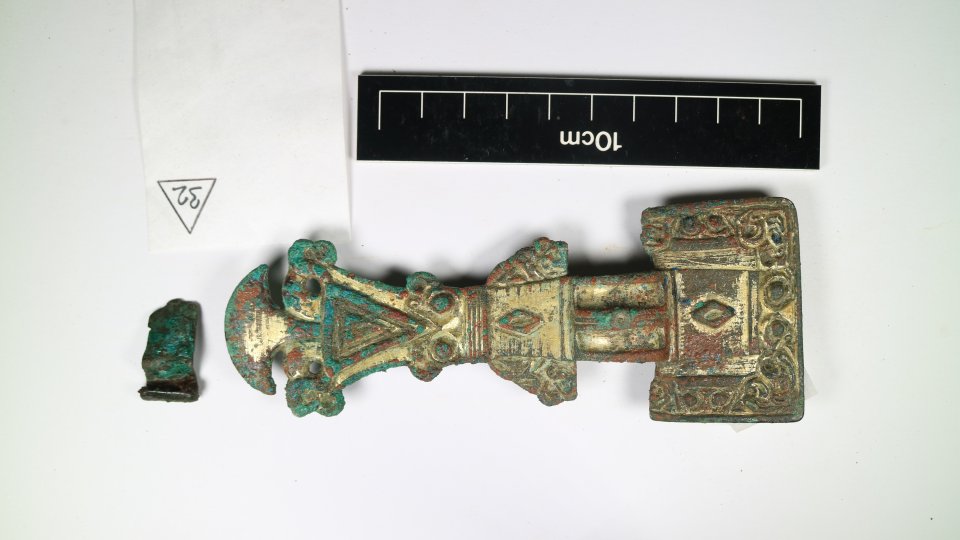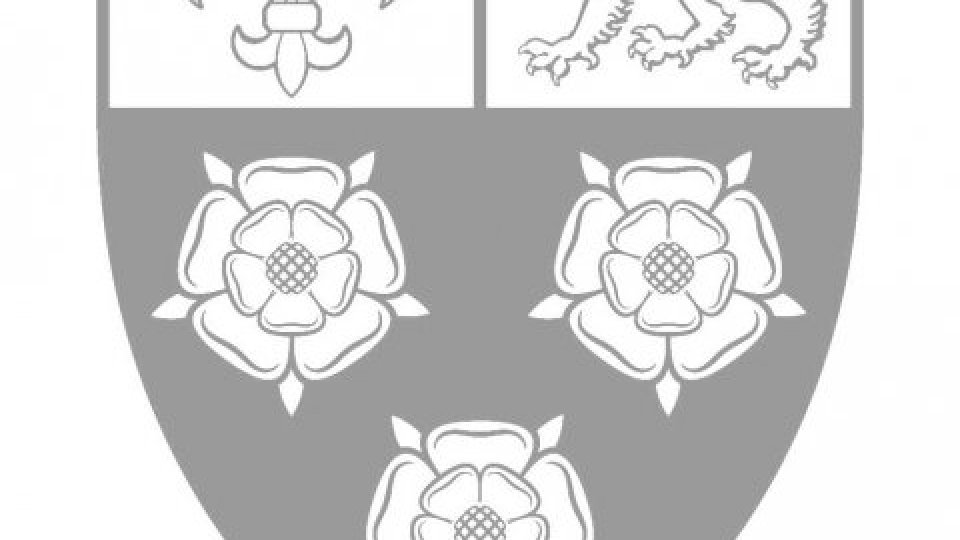
In autumn of 2020 Albion Archaeology excavated part of an Anglo-Saxon cemetery on the site of Croft Gardens, Cambridge, in advance of the construction of new King’s College accommodation on the site. The excavation uncovered sixty-two graves. The cemetery was in use for perhaps 150 years, from the mid-to-late fifth century onwards, a date confirmed both by the archaeological dating of the many objects deposited as grave-goods and by a series of radiocarbon dates. The many grave-goods found in the burials include weaponry, dress accessories like brooches, buckles and pins, glass, amber and jet beads, glass and ceramic vessels, and tools like knives, keys and spindle whorls. The population of sixty-nine individuals was composed of both adult men and women, as well as a number of children. There is no evidence of contemporary early medieval settlement within the excavated area. Instead, the space now occupied by Croft Gardens had – 1400 years ago – been set aside as a dedicated cemetery, to which the community returned over several generations.
The recent discoveries at Croft Gardens have much to tell us about life and death, community and society in early medieval Cambridgeshire. Central to the importance of the site is that it represents the largest Anglo-Saxon burial ground in Cambridge to have been excavated to modern standards and fully recorded. Research currently underway aims to examine the Croft Gardens population holistically, looking at identity, health, diet, genetics, social relationships and burial practices, using a suite of cutting-edge scientific techniques.
One important facet of the research undertaken to date has been archival in nature, exploring how the Croft Gardens cemetery fits into its immediate landscape context. The excavations in 2020 uncovered only part of what was originally a larger cemetery, which extended both eastwards, beneath neighbouring properties on Barton Road, and north, underneath the road itself.
History of the Site
Archaeologists have long known about the existence of an important early medieval burial ground in this part of Cambridge. Cyril Fox discusses the Newnham Croft cemetery, as he calls it, in his Archaeology of the Cambridge Region (1923), published almost a century ago, and the site was also listed in Audrey Meaney’s Gazetteer of Early Anglo-Saxon Burial Sites (1964). Chance discoveries of early medieval objects and burials were made throughout the nineteenth and twentieth centuries. A collection of objects recovered from graves found in the gardens of what was then Croft Lodge, to the east of the modern Croft Gardens site, were found in the 1880s and sold to the Cambridge University Museum of Archaeology and Anthropology (MAA) in 1936. The brooches, wrist-clasps and beads in the collection represent perhaps one or two female burials, while correspondence from the time suggests a broken pot was found separately, likely in another grave. The presence of a spearhead might suggest an additional male burial. Two further graves were found on the site of the former Croft Lodge in 1910 and the objects they contained were sold to the MAA. These were probably also both female graves, one containing three large copper-alloy cruciform brooches and the other a smaller brooch and a wrist-clasp.
Although found to the east of the Croft Gardens site, it is very likely the Croft Lodge graves originally formed part of the same cemetery. The range of objects recovered from the Croft Lodge site and their date is entirely consistent with the discoveries from the more recent excavations. Indeed, there are some intriguing similarities between the two. One of the objects discovered in the 1880s was a large dress pin with attached decorative spangles (see image, above). Pins of this type are relatively rare finds in early medieval cemeteries, but such pins were worn by and buried with two individuals in the Croft Gardens community, since a second spangle-headed pin was discovered in grave 16, the burial of a child of around nine years. Another material connection between the Croft Gardens cemetery and the Croft Lodge finds is an unstratified find of a wrist-clasp from the 2020 excavations. Wrist-clasps were worn in pairs to close the cuffs of sleeved gowns, with one side having a hook and the other an eye. The Croft Gardens clasp is identical in shape and size to one found at Croft Lodge over a century ago; they were plausibly cast from the same mould.
Later Excavations
Further graves were uncovered during the 1930s in the garden of 24 Barton Road, immediately opposite Croft Gardens. Archaeologist T. C. Lethbridge, who excavated a number of other important early medieval cemeteries in Cambridgeshire and Suffolk, at Burwell, Shudy Camps and Mildenhall respectively, examined five graves at 24 Barton Road in 1933. Objects from these graves, including wrist-clasps, a belt buckle and a spearhead, are now in the MAA. Further discoveries were made the following year, including the burial of a man with a spear. These graves are important because they confirm that the Croft Gardens cemetery as a whole occupying land that now sits either side of the Barton Road. Although the total size of the cemetery is a matter for speculation, at least thirteen graves can be shown to have been uncovered during the nineteenth and twentieth centuries, in addition to the sixty-two burials discovered in 2020.
Other earlier discoveries in the vicinity of Croft Gardens are less certain, but still intriguing. An iron axe-head that could be early medieval in date was reported to have been found in the centre of Barton Road in 1903, close to the intersection with Grange Road, probably within 100m of Croft Gardens. Although unusual, axes are sometimes found in early medieval burials, including in one grave at the Girton cemetery. This find could imply the spread of graves to the north-west of the known Croft Gardens cemetery. Also of interest are two cremation urns, now in the collections of the British Museum, said to have been found at Newnham in the later part of the nineteenth century. Their relationship to the Croft Gardens finds is unclear, given the lack of detailed records. However, it would not be unusual for a cemetery like Croft Gardens to have originally comprised both inhumation graves and cremations contained in urns. Both burial rites were practised in fifth- and sixth-century East Anglia, often by the same communities. In Cambridge, both the major cemeteries at Girton and at the St John’s Cricket Field site contained a mixture of inhumations and cremations.
By examining the available records concerning chance discoveries of early burials and artefacts along the Barton Road, a fuller picture of the Croft Garden cemetery emerges, and sheds new light on the recent discoveries made at the site.
Further Information
The MAA online catalogue is fully searchable - simple searches for ‘Croft Lodge’ and ‘Barton Road’ will bring up a list of the objects discussed here, in addition to other finds from the same area.

